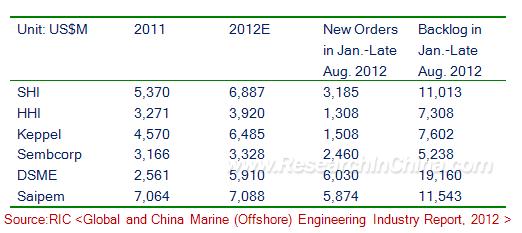Global and China Marine (Offshore) Engineering Industry Report, 2011-2012 highlights the followings:
1. Overview of offshore engineering
2. Market of offshore production facilities
3. Market and industrial pattern of offshore drilling platform
4. Market and industrial pattern of offshore support vessel (OSV)
5. 12 offshore engineering enterprises
The shipbuilding industry has been sluggish since H2 2011. In contrast, the offshore engineering industry is in a much better condition. In H1 2012, the fulfilled orders of global offshore engineering market totaled USD30.8 billion, equivalent to 52% of the total order value in 2011 and far surpassing the deal of USD23 billion in 2010, though being lower than the deal of USD36.9 billion in H1 2011.
As of the end of July 2012, there had been 74 backlogs for production facilities in the world, basically flat with the same period of 2011. The backlogs include 49 FPSOs, 6 Semis, 3 TLPs, 4 Spars, 3 FLNGs and 9 FSRUs, 40 of which would employ special-purpose hulls and 34 of which would be converted from oil tankers, with the number of converted oil tankers climbing. Of all 74 backlogs, 42 of them are owned by oilfield operators and 32 of them are controlled by contracting parties. Brazil still serves as the biggest customer and contributes 28 orders. From January-September 30, 2012, the new orders for FPSOs amounted to 14, covering 7 converted ones, 5 newly-built ones, and 2 redeployed ones.
It is estimated that there will be 20-22 new orders for FPSOs in 2012, but the market seems less boomy than expected.
With respect to the drilling rig market, Jack-up enjoys the lion's share. By September 30, 2012, there had been 72 backlogs worldwide. Singaporean Keppel had 40 backlogs, and Sembcorp held 23 backlogs. Between 2000 and September 30, 2012, there had been a total of new orders for 103 drillships. In January-September 30 of 2012, there were 11 drillship orders, 7 of which were secured by Samsung Heavy Industries, 2 by Hyundai Heavy Industries, 1 by DSME, and 1 by Sembcorp. The semi-submersible oil rig shows significant sign of recovery. During the same period, a total of 9 semi-submersible rigs were delivered, equivalent to the total delivered volume throughout 2011.
In H1 2012, the new orders for OSVs (excluding drillship) reached 127. Platform supply vessel (PSV) still acted as the mainstream type and ranked No.1 among the ship types by 58-vessel orders, followed by anchor handling tug supply (AHTS) vessels with 36-vessel orders. The orders for multipurpose supply vessel (MSV) numbered 12 and won the third place. In addition to the traditional mainstream ship types, seismic survey vessels and C, U & FP Lays also presented impressive performance, with trading volume getting to 11 and 5 respectively. But Sinopacific Shipbuilding Group leading the global offshore engineering market and Fujian Southeast Shipyard noted for its outstanding performance failed to obtain new orders in H1 2012.
DSME makes the most astounding progress in 2012. By the end of August 2012, DSME had obtained new offshore engineering orders worth USD6.03 billion, almost flat with a record high of USD6.29 billion in 2011. It is expected that it will acquire new orders of USD9.6 billion throughout 2012. The major orders of DSME cover the world's second LNG-FPSO costing USD777 million (the first one was built by Samsung Heavy Industries) and 2 semi-submersible drilling rigs costing USD1.1 billion.

Saipem principally engages in offshore engineering construction and specializes in subsea pipeline laying. SHI and HHI devote themselves to drillships. DSME is committed to FPSO, semi-submersible oil rig, and drillship. Keppel takes FPSO and Jack-up as its main business. Sembcorp is involved in Jack-up and semi-submersible oil rig. DSME will undoubtedly become the leader in offshore engineering industry in 2013 even 2014 in terms of new orders.





